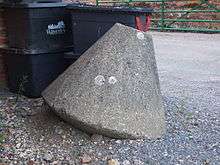Buoy anti-tank obstacle
Buoy is a British type of anti-tank obstacle used to block roads intended to impede enemy movement.[1] Buoys were widely deployed during the invasion crisis of 1940–1941. Each buoy was a truncated cone of concrete with a rounded bottom, about 2 feet 9 inches (84 cm) high, and with a 2 inches (50 mm) diameter hole through the axis. They would be placed in at least five rows across a roadway.


Buoys were intended as an alternative to a simple cylinder of concrete. The advantage of buoy was that it could be used to block or unblock a road quickly. Passing a rod or crossbar through a pair of buoys formed a wheeled axle that could easily be rolled into place; when the axle was removed the buoys could be separated and stood up. Although easily knocked over, the conical shapes could not be rolled very far, they would move unpredictably and out of the field of view of a tank driver, making it difficult to avoid them.[2] They were eventually judged to be ineffective and phased out.[3][4]
Extant examples are often found by the roadside today.[5][6][7]
See also
- British anti-invasion preparations of World War II
- British hardened field defences of World War II
References
- "Buoy". Online Thesaurus. English Heritage. Archived from the original on 23 June 2007. Retrieved 20 August 2010.
- War Office. Military Training Pamphlet No 30, Part III: Obstacles. 8 October 1940, p. 15
- Ruddy 2003, p. 27.
- Wills 1985, p. 41.
- "HER 6030 - ANTI TANK BLOCKS: South Garlswood, on the edge of Petridgewood Common, Off A23". Exploring Surrey's Past. Retrieved 20 August 2010.
- "Roadblock Recce (38) Michelham Priory". Defences of East Sussex Project. Retrieved 1 June 2019.
- "Roadblock Recce (37) Rotherfield area". Defences of East Sussex Project. Retrieved 1 June 2019.
General references
- Foot, William (2006). Beaches, fields, streets, and hills ... the anti-invasion landscapes of England, 1940. Council for British Archaeology. ISBN 1-902771-53-2.CS1 maint: ref=harv (link)
- Osborne, Mike (2004). Defending Britain ... twentieth century military structures in the landscape. Tempus Publishing. ISBN 0-7524-3134-X.CS1 maint: ref=harv (link)
- Ruddy, Austin (2003). British Anti-Invasion Defences 1940–1945. Historic Military Press. ISBN 1-901313-20-4.CS1 maint: ref=harv (link)
- Wills, Henry (1985). Pillboxes: A Study of UK Defences. Leo Cooper. ISBN 0-436-57360-1.CS1 maint: ref=harv (link)